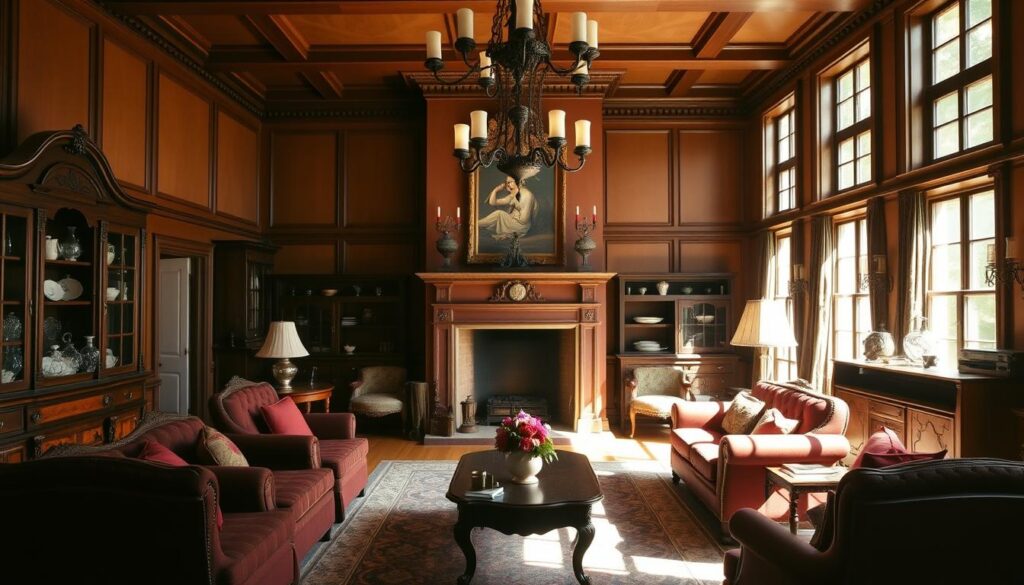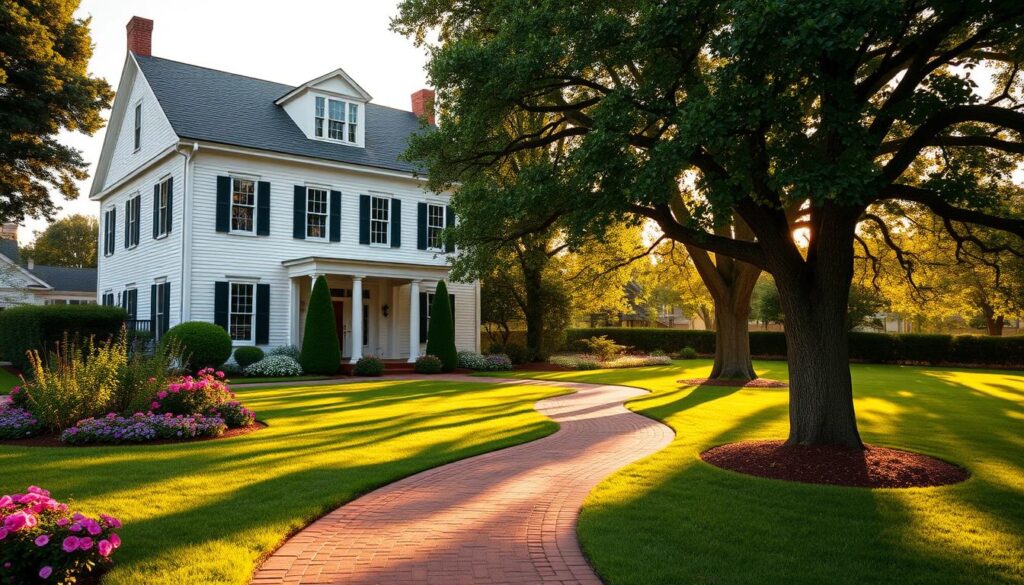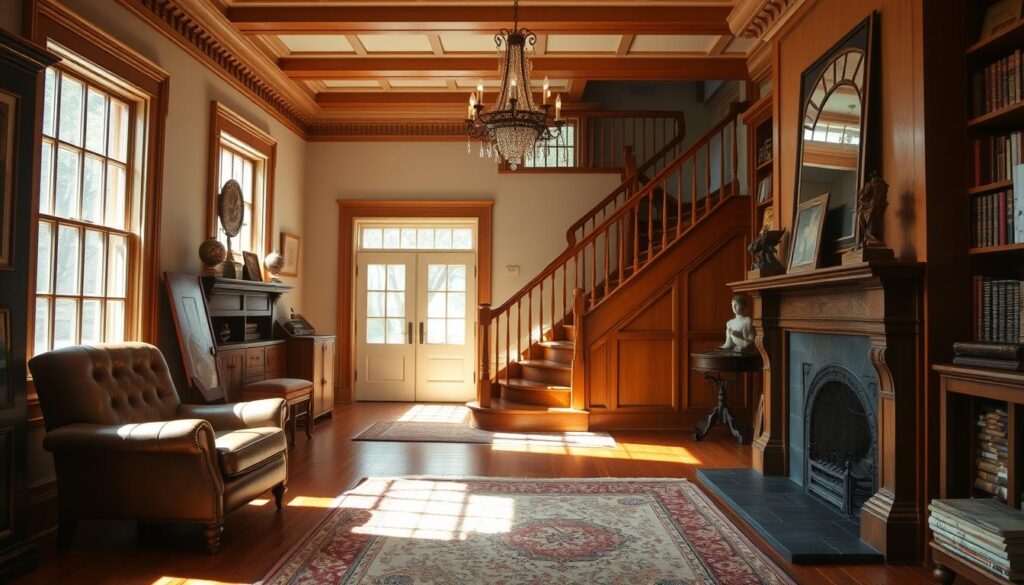Did you know colonial-style homes are super popular in the U.S.? They’re known for their classic beauty and timeless charm. This makes colonial interiors a favorite among homeowners today.
We’ll show you how to design a stunning colonial interior. We’ll cover traditional flooring, iconic colors, and classic furniture styles.
By the end of this guide, you’ll know how to create a beautiful, authentic look.
Key Takeaways
- Understand the colonial aesthetic and its key elements.
- Choose the right color palette for your colonial-style interior.
- Select authentic colonial furnishings and decor.
- Learn about traditional flooring options and their benefits.
- Create a timeless and elegant colonial interior.
Understanding the Colonial Home Aesthetic
Embracing the colonial home aesthetic means adding elements that show simplicity and symmetry. To make a stunning colonial home interior, we need to know the key elements of this style.
Characteristics of Colonial Architecture
Colonial architecture is known for its symmetry and classic elements. It often has a central front door, evenly spaced windows, and a balanced facade. This style focuses on simplicity and proportion, creating harmony and order.
Some common features include:
- Rectangular or square shape
- Symmetrical facade
- Multi-paned windows
- Classic door surrounds
Popular Colonial Home Styles
There are several popular colonial home styles, each with its own twist on traditional design. These include:
- Dutch Colonial, known for its gambrel roof
- Spanish Colonial, characterized by its use of stucco and ornate details
- Georgian Colonial, recognized for its symmetrical facade and classical details
Each style adds to the rich tapestry of colonial style decor. They offer a variety of options for homeowners who want to embrace this traditional aesthetic.
Historical Significance of Colonial Design
The historical significance of colonial design is huge. It shows the cultural and architectural influences of early European settlers in America. It blends their traditions with the needs of the New World. This style has lasted, remaining a favorite for homes today because of its timeless appeal and traditional colonial design elements.
By understanding the historical context of colonial design, we can better appreciate its impact on modern interior design and architecture.
Key Elements of Colonial Home Interiors
A colonial home interior is all about traditional flooring, iconic colors, and classic furniture. These elements come together to make a historic home interior that feels both real and welcoming.
At the heart of a colonial home is its flooring. These floors have been around for ages, adding warmth and character to the space.
Traditional Flooring Options
Hardwood floors, like oak and pine, are common in colonial homes. They’re durable and look great, making them a favorite among homeowners today. As “the choice of flooring can greatly impact the overall aesthetic of a room”, experts say.
Other classic flooring options include wide-plank floors and finishes that look like they’ve been around for years. These add to the home’s historic charm.
Iconic Color Palettes
The color scheme is key in a colonial home interior. Neutral tones like beige and white are typical, offering a clean and timeless look.
Design historians say,
“neutral colors let you add richer, bolder colors through furniture and decor. This creates a balanced and harmonious space.”
Classic Furniture Styles
Classic furniture, like four-poster beds and wingback chairs, are symbols of the colonial style. These pieces are not just useful but also add to the home’s beauty.
When picking furniture for a colonial home, look for pieces that show off craftsmanship and traditional building methods. This way, homeowners can create a historic home interior that’s both stunning and true to its roots.
Choosing the Right Color Scheme for Colonial Homes
The right color scheme can make your colonial home warm and inviting. It honors its classic heritage. Choosing a color palette that is both authentic and pleasing is key.
Neutral Tones and Their Impact
Neutral tones like beige and white are essential in colonial design. They bring calm and serenity, making a clean backdrop for vintage colonial furnishings. These colors also reflect light, making rooms seem larger.
Accent Colors to Consider
Neutral tones are the base of a colonial color scheme. Accent colors add depth and interest. Traditional colors like red and blue were used in colonial times. Use them in furniture, rugs, and accessories for a pop of color.
Incorporating Textures into Your Palette
Texture is also crucial in colonial homes. Mixing textures, like wood furniture and linen upholstery, adds depth. Natural materials like wood, stone, and brick enhance authenticity.
By balancing neutral tones, accent colors, and textures, you create a warm and welcoming space. It respects the colonial style while making your home cozy.
Selecting Authentic Colonial Furnishings
To make your home look like a colonial home, pick furniture that shows the style’s history. The right furniture can take you back in time. It brings the elegance and simplicity of the colonial era to your home.

Tips for Finding Antique Pieces
Antique furniture is key to a real colonial look. Look for these treasures at:
- Local antique shops and vintage stores
- Estate sales and auctions
- Family inheritance or heirlooms
When checking out antique pieces, look for signs of age like patina. Also, check their condition. The craftsmanship and materials used are important for authenticity and value.
Modern Reproductions of Colonial Furniture
Not everyone can find or afford real antique pieces. Modern colonial furniture is a good choice. It lets you enjoy the colonial style without the high cost or rarity issues.
When picking modern reproductions, look for:
- Materials that look like the originals
- Craftsmanship that shows traditional skills
- Designs that stay true to the colonial style, with lots of detail
Importance of Craftsmanship
Craftsmanship is what makes colonial furniture special. It shows the skill and hard work of the makers. Choose furniture, whether antique or modern, that shows great craftsmanship.
Well-crafted colonial furniture has:
- Details in carvings, joinery, and finishes
- Traditional techniques and tools
- Materials that last a long time
By focusing on these, you can make a colonial home that looks great and has a lot of history and character.
Maximizing Space in Colonial Interiors
Designing colonial interiors to maximize space is key. Colonial homes often have smaller rooms. It’s important to use the space wisely. We’ll look at how to make the most of your colonial home’s interior.
Open vs. Defined Spaces
Choosing between open or defined spaces is a big decision. Open spaces can make rooms feel larger. Defined spaces keep the classic feel of colonial homes. For more on colonial revival design, check out this resource.
Furniture Arrangement Tips
Arranging furniture well is crucial in colonial homes. Here are some tips:
- Choose multi-functional furniture to cut down on clutter and boost functionality.
- Go for furniture with legs instead of bulky bases to open up the space.
- Make sure your furniture fits the room size to avoid overwhelming it.
Utilizing Built-In Features
Colonial homes often have built-in features like shelving and storage nooks. Using these can greatly improve your home’s look and function. For example, built-in shelving can hold decorative items or books, keeping the floor clear.
By smartly arranging your furniture and using built-in features, you can create a beautiful and functional colonial home interior.
Incorporating Decorative Elements
Decorative elements are key in designing a colonial home interior. They include window treatments, lighting fixtures, and wall art. These elements greatly enhance your home’s look.
Window Treatments That Complement Colonial Design
Window treatments are more than just functional. They are a crucial part of colonial home decor. Traditional options include:
- Wooden shutters that add a touch of authenticity
- Heavy drapes or curtains made from rich fabrics like velvet or silk
- Roman shades that offer a clean, elegant look
These treatments not only control light but also add to the colonial style.
Selecting Appropriate Lighting Fixtures
Lighting fixtures in a colonial home should show the period’s craftsmanship and elegance. Consider:
- Chandeliers with intricate metalwork or crystal embellishments
- Sconces that are mounted on walls to provide ambient lighting
- Lantern-style lights that echo the historical significance of colonial design
These lighting choices can dramatically impact your home’s ambiance. They make it feel more authentic and inviting.
Wall Art and Accessories
Wall art and accessories are the final touches for a colonial home interior. Consider incorporating:
| Item | Description |
|---|---|
| Antique Maps | Historically significant and aesthetically pleasing |
| Colonial-era Reproductions | Artwork that reflects the style and themes of the colonial period |
| Traditional Craftsmanship | Pieces that showcase the skill and artistry of colonial craftsmen |
By carefully choosing these decorative elements, you can create a colonial home interior that is both beautiful and historically respectful.
The Role of Textiles in Colonial Design
Textiles are key in colonial home interiors, adding depth and history. The choice of fabrics, rugs, and textiles greatly affects a room’s look and feel.
Fabrics to Enhance Historical Authenticity
To make a colonial home feel real, pick fabrics from the colonial era. Cotton and linen were top choices for their durability and comfort. These natural fibers work well for upholstery, drapery, and more.
Using these fabrics brings the colonial era to life. For instance, linen was great for curtains and upholstery because of its durability and natural feel.
Layering Textiles for Comfort and Style
Layering textiles adds depth and interest to a room. In colonial homes, this was done with throw blankets, rugs, and furniture. It made the space warm and stylish.
To layer textiles well, start with a rug. Then add throw blankets and pillows. This makes the space cozy and welcoming.
“The right textiles can transform a house into a home, adding warmth, texture, and a sense of history.”
Patterns Commonly Found in Colonial Homes
Colonial homes had many patterns, from simple stripes to detailed florals. These patterns were in fabrics, rugs, and wallpaper.
| Pattern Type | Common Use | Historical Significance |
|---|---|---|
| Stripes | Upholstery, drapery | Simple, durable, and versatile |
| Florals | Upholstery, wallpaper | Influenced by European designs, symbolizing prosperity |
| Toiles | Upholstery, drapery | Featured pastoral scenes, reflecting rural life |
Using these patterns in your colonial home design boosts its historical feel and beauty.
Landscaping and Outdoor Spaces
The charm of a colonial home is not just inside. It’s also in its landscaping and outdoor areas. When we talk about colonial home design, we must think about how outdoor spaces can match the classic look of these homes.

Creating a Colonial Style Garden
To make a colonial-style garden, use traditional plants and classic features. Plants like lavender, roses, and boxwood add a touch of history. Brick paths, wooden fences, and other traditional materials enhance the colonial feel.
Think about the colors and textures of your garden. A mix of bright flowers and greenery looks great. Adding vintage garden ornaments or antique replicas also adds to the colonial vibe.
Important Elements of Colonial Exterior
The outside of a colonial home is as important as the inside. Look for a symmetrical facade, classic shutters, and a traditional front door. Natural materials like brick, stone, or wood make the exterior look colonial.
Landscaping should match the home’s architecture. Plant trees and shrubs to frame the house and blend with nature. A neat lawn and trimmed hedges also add to the classic look.
Connecting Indoor and Outdoor Spaces
To link indoor and outdoor areas, use similar design elements. For example, vintage colonial furniture outside can tie in with the inside decor.
Big windows and doors help merge the indoors with outdoors. They let in natural light and offer views of the garden or yard. Outdoor lighting that matches the indoor lights also helps connect the spaces.
Sustainable Practices in Colonial Home Design
Sustainable practices are key in colonial home design. They help us lower our environmental impact while keeping the homes’ historical charm.
In colonial era interior design, adding eco-friendly elements is crucial. It’s a way to respect our colonial ancestors’ resourcefulness. The right materials and practices make our homes more sustainable.
Choosing Eco-Friendly Materials
Choosing the right materials is vital for sustainable colonial home interiors. Reclaimed wood adds character and saves new lumber. Sustainable fabrics like organic cotton and recycled materials are great for upholstery and window treatments.
Experts say using local materials cuts down on carbon footprint. This fits well with the colonial spirit of self-sufficiency.
“The greenest building is the one that is already built.” This quote highlights the importance of preserving existing structures. It’s at the core of historic preservation.
Benefits of Historic Preservation
Preserving colonial homes is essential. It keeps their historical significance and reduces environmental impact from new buildings.
Restoring historic homes requires careful thought. Focus on keeping original materials and craftsmanship. This preserves the home’s history and supports local jobs.
Sustainable Landscaping Ideas
Sustainable landscaping is crucial for eco-friendly colonial home design. Native plants and water-efficient systems cut down water use.
A colonial-style garden with herbs and veggies boosts the home’s look. It also gives a fresh produce source. This landscaping is good for the environment and respects history.
- Use native plants to reduce water consumption.
- Implement rainwater harvesting systems.
- Incorporate edible landscaping for a sustainable food source.
By adopting sustainable practices in colonial home design, we ensure these homes last for many years. They mix historical charm with modern eco-friendliness.
Common Mistakes to Avoid in Colonial Interiors
A well-designed colonial interior needs a good grasp of the style’s details and common errors. Homeowners often face challenges when trying to achieve a traditional colonial look. These challenges can spoil the overall look.
Overlooking Scale and Proportion
One big mistake is ignoring the size and balance of furniture and decor. In colonial homes, it’s key to find a balance between grand and cozy. Too big furniture can make a room feel tight, while too small pieces can make it seem empty.
To get it right, measure your rooms well and pick furniture that fits. Think about the size of things like doorways, windows, and fireplaces when picking decor.
Mixing Too Many Styles
Colonial style decor is known for its classic beauty. Mixing too many styles can mess with this beauty and make the look feel off. To keep it real, stick to traditional colonial pieces and avoid too many modern or bold items.
“The key to a successful colonial interior is restraint. Avoid the temptation to mix too many styles, and instead, focus on classic, timeless pieces that reflect the era’s elegance.”
Neglecting Functionality
While looks are important, don’t forget about function. Colonial homes were made to be useful and cozy. Make sure your design choices don’t mess with how your space works.
| Design Element | Colonial Style Characteristic | Functional Consideration |
|---|---|---|
| Furniture | Classic, traditional designs | Comfortable, practical seating |
| Color Scheme | Muted, earthy tones | Consider the mood and ambiance desired |
| Lighting | Traditional fixtures like chandeliers | Adequate lighting for tasks and ambiance |
By watching out for these common mistakes, you can make a colonial interior that looks great and works well. The secret to a good design is finding the right balance and being careful with what you choose.
Final Touches for a Cohesive Look
To make a colonial home interior stunning, focus on details and design consistency. We’ve discussed many elements in this guide. Now, let’s see how they come together for a classic look that’s both historic and welcoming.
Consistency in Design Matters
Having a consistent design is key in a historic home. Choose furnishings, colors, and decorations that fit the colonial style. But also, make sure they show your personal taste.
Adding Personal Touches
To make your home truly yours, add personal touches. This could be family heirlooms, antique pieces, or unique decorations. They should enhance the classic colonial decor.
Maintaining Balance and Harmony
Balance and harmony are vital for a beautiful space. Think about how furniture, color, and texture are arranged. This way, your historic home interior will be both inviting and elegant.


